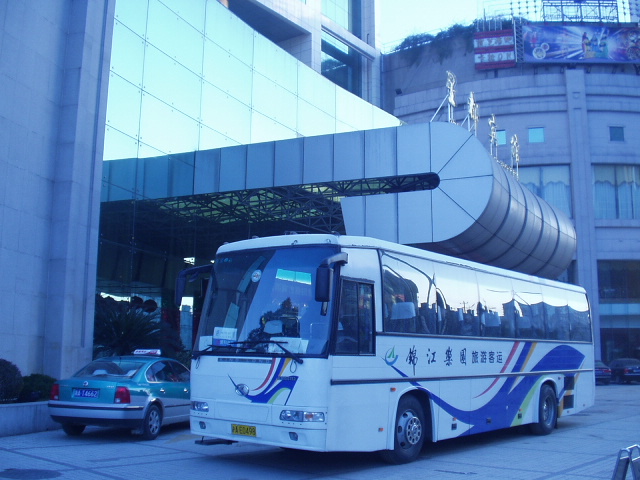


During the Lunar New Year Holidays in 2004, my family visited Shanghai(上海), Hangchou(杭州) and Shuchou(蘇州) in a packaged tour. Since my parents passed away, we were able to travel abroad because all the family members were free during the holiday season. Shanghai is a typical city in China that is rapidly developing and changing for the past decades. So we could witness what's going on in China, as if the Chinese people are traveling in a time machine from the feudal state to a modernized country. Shanghai was coerced to open to the Western Powers 150 years ago, but was reopened voluntarily by Great Leader Deng 12 years ago. Now it's one of the fastest changing cities in China.
In the early morning on January 20, I managed to drive to Incheon International Airport in time via a slippery highway owing to some snow in the previous night. It was because we could not catch a taxi in the early morning. We were four people with as many luggages.



Shocking impression from Shanghai
After 80 minutes since the Korean Air took off at Incheon Airport, we arrived at Pudong(浦東) Airport near Shanghai, a little far off Jeju from Seoul.
From the airport to the downtown Shanghai, there are a number of highways and an elevated railroad exclusive for high-speed magnetic levitation trains. Over the Hwangpo River which restricted the outward expension of Shanghai, more than ten bridges have been constructed to facilitate the traffic flows in and out. We sensed no traffic jam at all because there are networks of elevated roads at downtown.



Shanghai is the biggest port as well as the center of industry, finance, economy, trade, science, technology and culture in China. Six thousand years ago it was submerged under the water. Before the Opium War between China and the United Kingdom, it was a quite fishery town. But by the Nanjing Treaty, it was open to the British forces and other European states, the United States and Japan. A part of downtown Shanghai was leased to the Western powers, and was developed and changed as an international city.
Let bygones be bygone. In 1992, Deng Xiao Ping ordered to develop the Pudong area across the Hwangpo River.



It was no exaggeration at all what North Korean Leader Kim Jeong Il exclaimed to describe the development of Shanghai as a revolutionary change while visiting Shanghai in May 2000. Let's count the period for the capita income to become doubled. For example, London and New York took 50 to 100 years, Tokyo 30 years, Seoul 15 years thanks to the miracle of Han River, respectively. But Shanghai spent only 10 years.
The leadership of Socialist China proposed the blueprints of capitalist economic development, and induced the enormous inflows of foreign capital. It was made possible by the hard working Chinese people.



Behind the bright facade, however, there was a big shadow. When we visited the Provisional Government Office which was used by the Independent Nationalists during the Japanese occupation period, the poverty-stricken district was being renovated at large. According to rough statistics, there are more than 50 million billionairs. But absolutely large number of Chinese people, in particular, in the remote west provinces, are living with the income less than one thousand dollars a year.
Truly we saw the rich driving luxurious foreign-made vehicles, and at the same time, a number of peddlers who were selling one-dollar gifts to tourists.

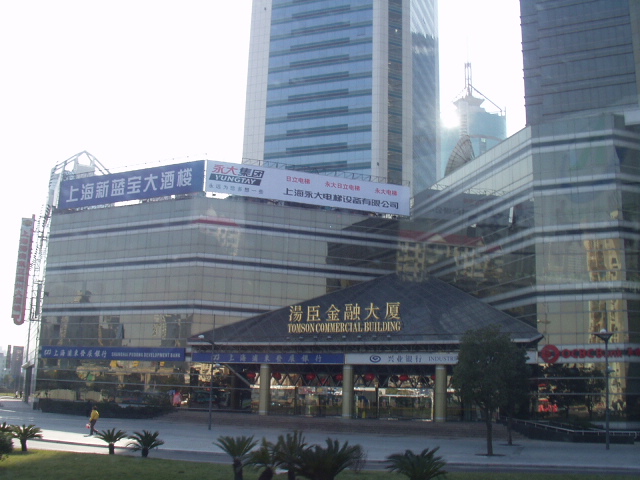

The night scenery from the Waitan(外灘) Area was magnificent like fire works. The 468 meter high Dazzling Pearl of the Orient Tower(東方明珠) looked like a space ship at the launching pad. It is the third tallest tower in the world, and the highest one in Asia being used as a transmitting tower.
We was going up to the Observatory at 263 meter high. In the basement, there was a historic museum which displayed an exhibition of the "Silk Road"(絲綢之路) through which the commodities and culture were exchanged between China and Europe. The tower was changing its lighting colors day and night depending on the weather.


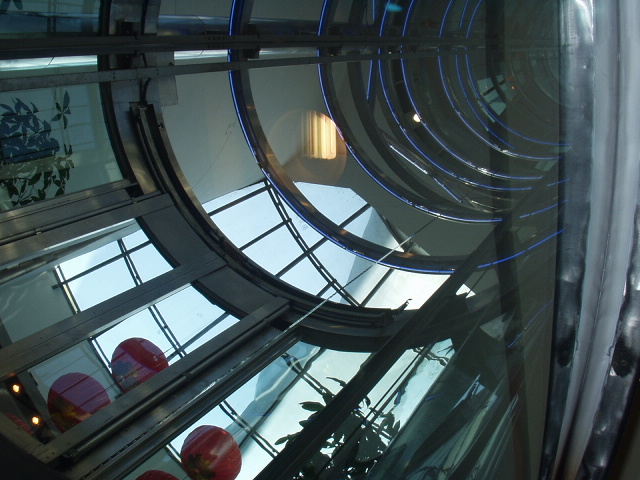
In the Hwangpo River area, large-scale ports, shipbuilding docks and factories were being developed showing robust activities.
It is said that the capacity of ports and logistics were already exceeding that of Busan.
China is not a country far behind us. Foreign capital inflows up to 50 billion dollars a year, economic growth rate over 7-9 percent a year, admission to WTO, Beijing Olympic Games in 2008 and Shanghai Expo in 2010 have catapulted China ahead of Korea. It could be believed that, within a few decades, China will catch up with Japan and the United States.



The Provisional Government Office was a symbol of the Independent Korea
We dropped in the Provisional Government Office which was used by the Nationalist Fighters from 1926 to 1932. The building was renovated under the auspices of the Korean government and businessmen after the establishment of diplomatic ties between Korea and China.
We looked around the halls displaying the historic relics and documents with our foots covered with plastic shoes. It was strictly prohibited to take pictures inside the building. The Provisional Government officials had to escape the Japanese police to Inland China just after the successful attack by Yoon Bong Gil against Japanese high-ranking officials and generals stationed to Shanghai.

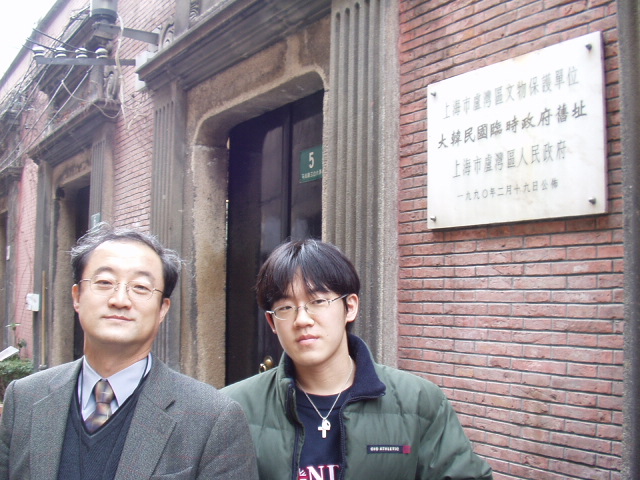

On April 29, 1932, when a ceremony was held by the Japanese Army Headquarters at the Hongkou Park celebrating the birthday of Japanese king, a Korean young man of 25 years old threw a bomb in a lunch box on the podium. He was arrested at the scene and later executed.
At that time, Chiang Che Su said, "A Korean young man has done a job which one billion Chinese people couldn't do."
We saw a memorial stone and a Korean style pavilion(梅亭) over the site. The playground where the military parade took place was changed into a pond, and the name of the park was also renamed after the Chinese novelist Lu Cine(魯迅). In the park, Chinese elder citizens were exercising Tai-chi at present.



Well paved but scarcely used Ho-Hang Highway connected Shanghai and Hangchou. At present, the large number of Chinese people prefer much cheaper traveling by train to express bus. So there were scant traffic notwithstanding the New Year holidays.
Along the highway, there were rich-looking villages where they raise two crops of rice a year and other lucrative plants for profits. The tour guide explained, "Their cottages are two or three-story houses, the first floor of which is only for warehouse and kitchen because of humidity, the second or third floor are used as living rooms and bed rooms. At the attic, there are shrines for ancestors."
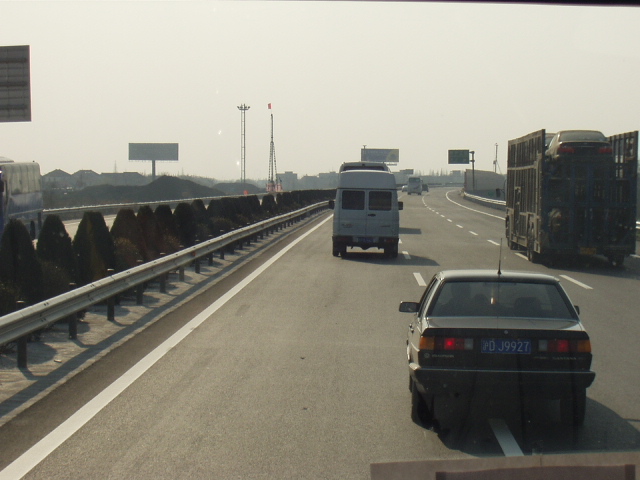


Hangchou kept well the old culture and civilization
At Hangchou, a new Chinese tour guide got on the bus subject to the local rule. We traveled to the Six Peace Tower(六和塔) which was erected a long time ago to make a wish preventing the backflow of Zendang River(錢塘江). Then we proceeded to the Song Castle(宋城) Folk Village, where an extravagant dancing shows were performed to revive the old culture of the Song Dynasty. We tried the relish of the traditional tea at Yongjeong Tea Village and had the dinner at the Sport Complex of Hangchou.
We put up at a four-star hotel. At midnight, we couldn't sleep at all. It is a New Year Day(春節)! Chinese people here and there, everywhere were making a wish by firing a bundle of firecrackers. Although they were beautiful fireworks, the tourists inside the hotel had difficulties to make a good sleep.



At six o'clock in the morning of the first day of a New Year (by a lunar calendar), we woke up at the morning call. After the breakfast, we enjoyed the early morning cruise at Seo-Ho(西湖, West Lake).
The Great Poet So Dong Pa(蘇軾, 1036-1101), the Magistrate of Hangchou in the Song Dynasty, wrote a number of poems as the season changed. A Korean poet, named Jeong Chul, longed for the mystic scenery of this lake in his poems. We walked around the lakeside park, and ate the world-famous pork seasoned with liquor "Dong Pa Yook"(東坡肉) and "Beggar Chicken" (roasted chicken covered with mud) at the Lily Hotel restaurant.



After lunch, we visited one of the biggest temples in China, Young Eun Sa(靈隱寺). There were a flood-like visitors far from the entrance. We were impressed by the size of the temple and the big statue of Buddha in the main temple.
Imagine its size by measuring the ear of 1.5 yard long. Its sitting height is more than 83 feet. There were more than five hundred statues around the main Buddha statue. All the visitors looked very serious. But my wife hated the smell of burning wooden sticks for worship.



The ideologies or the government systems couldn't stop the tradition of Chinese people, like fire cracking and burning the wooden sticks for worship. More than 70 percent of population are said to belong to the Buddhism, while other religious sects are expanding its believers after the political reform in the 1980s.
Though the communist China allows the freedom of religion, only adults over 18 years old are permitted to keep faith, but prevented from conveying their belief to others. Pa Roon Gong(法輪功) has been declared illegal in China.



There are a big mansion and a beautiful garden which every tourist wants to visit.
The mansion was owned by the powerful merchant named Ho Seol Am(胡雪巖, 1823-19?) in Ching (Mandarin) Dynasty. We found a labyrinth inside the mansion where residents were walking around drinking tea, chatting each other, and reading books. It was amazing to see very tall walls around the mansion.
On the contrary, Zol Garden(拙庭園), which was made in Ming Dynasty, showed the dilettantish flavor and ambition of its owner, Wang Hyun Shin. The garden was composed of wide open garden and studies, separate houses. It was decorated with a variety of flowers, trees and bamboos. The windows was made of Italy-made glasses. To our disappointment, this magnificent real estate was conveyed to others by a prodigal offspring who was indulged in gambling.



Like a heaven, there are Dong Ri and Shuchou on the earth.
We dropped in Dong Ri(同里) on the way from Hangchou to Shanghai. It was a riding course in a man-pulled car and a small cruise in the city canals. Because we spent a lot of time at the temple, it was late in the evening. It was getting dark.
As for me, it was compared to the River Walk in San Antonio, Texas which I once visited during my stay in Dallas. Around Dong Ri, new industrial sites were being constructed to accommodate large companies and factories.



At Shuchou, we had to visit Han San Temple(寒山寺), the Tiger Hill Tower(虎丘塔) and Zol Garden(拙庭園).
Han San Temple is relatively small, but it has been famous owing to a poem(楓橋夜泊) in Tang Dynasty. It says, "When the moon sets, and crows are weeping, there is frost everywhere. Though I try to sleep looking at the lamps of a fishing boat under the bridge, a bell is ringing from Han San Temple out of the castle. The bell sound is awakening a stranger in the boat."
The Tiger Hill Tower is another leaning tower in China where a king named Hap Ryo(闔閭) was buried in an unidentified tomb. We took a picture with Chinese soldiers on leave.
We also visited a silk factory where we bought a pack of silk bedclothes. Later we dropped in a foot massage parlor and had a rest. We had only to pay a tip of two dollars each because the fee was included the traveling expenses.
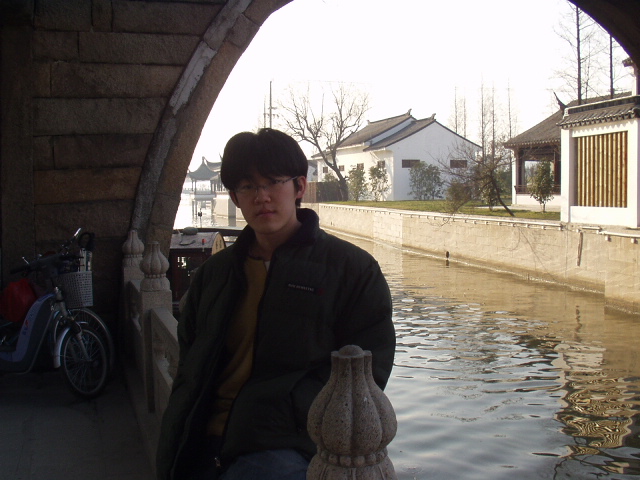
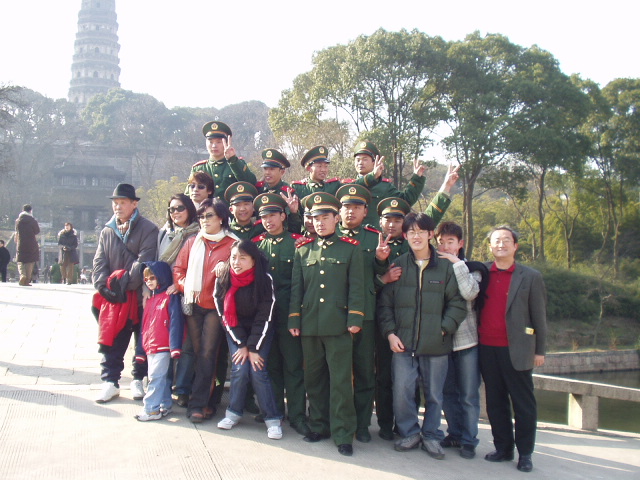

At Shanhai, we stayed at the Holiday Inn(暇日) near Shanghai Station. It was cold inside the hotel room because the hotel had a poor heating system. In fact, heating is not necessary in the sub-tropical climate.
There was a final "must see" in Shanghai, e.g., the Shanghai Circus. We went to the theater at 7:30 p.m. and enjoyed the performance for one hour and a half. The performers showed us the extreme postures how a man or woman is moving and shaping. The acrobats were playing like monkeys hanging around a pole. At the final stage, four riders of autobicle were driving their cars in a big ball. Their perfomances were very dangerous but spellbinding
At that time, a tourist told my son who will become a 12th grader who should prepare for the entrance exam, "Look at that. To study is the easiest job in the world, isn't it?"
In the Korean version
